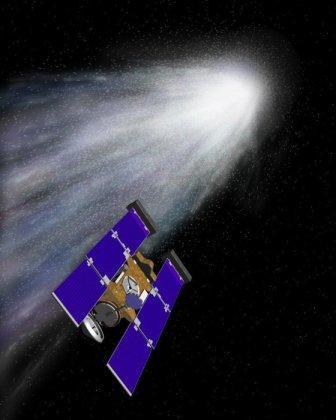A U.S. spacecraft’s long-awaited rendezvous with a comet will finally be realized on Valentine’s Day.
The comet explorer Stardust-NExT (New Exploration of Comet Temple 1) will approach the comet Temple 1 at a distance of only 200 kilometers at 8:37 p.m., PST, Feb. 14 (1:37 p.m., Feb. 15 in Korea) and NASA will broadcast the encounter live on NASA Television and the agency’s website from 8:30 p.m. PST.
“Since 2007, Stardust-NExT executed eight flight path correction maneuvers, logged four circuits around the sun and used on Earth gravity assist to meet up with Temple 1,” NASA said in its statement on Jan. 19.
When they meet up, the Stardust-NExT will be able to measure the composition, size, dust properties of the comet and provide information on how Jupiter-family comets evolve and how they formed 4.6 billion year ago, NASA’s Jet Propulsion Laboratory explained in an article.
 |
NASA representation of its spaceship Stardust on its way to bring the first samples of a comet back to Earth. Stardust will reach Comet Wild-2 in January, 2004, after a five-year voyage, and return its payload of comet dust two years later. (MCT) |
The comet Temple 1, which is about six kilometers wide, travels on an orbit that brings it as close to the Sun as Mars and as far away as Jupiter, and was spotted by NASA’s Deep Impact mission in 2005 as comet was shooting toward the Sun on its five-year orbit between Mars and Jupiter.
Now space experts want to see how the comet has changed after its tour around the Sun.
NASA’s Stardust mission was launched in Feb. 7, 1999 to collect samples from a comet and return them to Earth for study. The mission is managed by NASA’s Jet Propulsion Laboratory in California and the spacecraft is built by Lockheed Martin Space Systems.
Live coverage schedule from NASA (all times PST and subject to change)
8:30 to 10 p.m., Feb. 14 | Live NASA TV commentary begins from mission control; includes coverage of closest approach and the re-establishment of contact with the spacecraft following the encounter. |
Midnight to 1:30 a.m., Feb. 15 | NASA TV commentary will chronicle the arrival and processing of the first five of 72 close approach images. The images are expected to include a close-up of the comet’s surface. |
10 a.m. Feb. 15 | News briefing |
Where to watch | |
For more information | |
By Lee Woo-young and news reports (
wylee@heraldcorp.com)
Edited by Rob York
<관련 한글 기사>
혜성 탐사선 스타더스트호, 발렌타인데이에 혜성과 만나
 |
(NASA) |
지난 2004년 혜성 빌트-2에 접근해 구성 물질과 성간먼지를 수집한 미국항공우주국(NASA)의 혜성 탐사선 스타더스트호가 오는 2월14일 다음 연구 대상인 템펠1에 근접 비행을 하게 된다고 스페이스 닷컴이 보도했다.
1999년 발사된 스타더스트호는 2004년 빌트-2의 꼬리 부분을 지나가면서 표본 물질을 성간먼지포집기로 포착해 2년 뒤 이를 실은 캡슐을 미국 유타주의 사막에 착륙시켰다.
이후 비행을 계속하면서 스타더스트-NExT(New Exploration of Tempel 1)라는 새로운 이름이 붙여진 이 탐사선은 템펠1의 전체 영상과 2005년 7월 딥 임팩트호의 충돌체가 템펠1에 남긴 충돌 구덩이의 고해상도 영상을 확보할 계획이다.
충돌 당시엔 먼지 파편 구름이 짙어 새로 형성된 지형을 볼 수 없었다.
스타더스트-NExT 연구팀은 이 탐사선이 템펠1을 약 200㎞ 거리에서 지나갈 것이며 5분동안 72장의 사진을 촬영할 계획이라고 밝혔다.
오는 2월7일이면 발사 후 12년이 되는 스타더스트호는 현재 연료가 거의 바닥난 상태로 노후한 배터리의 기능도 전만 못해 NASA 관계자들은 이번 임무를 끝으로 이 탐사선이 3월이나 4월 중 영원한 작별을 고하게 될 것이라고 말했다.
과학자들은 스타더스트가 더 이상 과학적 가치가 있는 사진을 찍지 못하게 되면 남은 연료를 추진용으로 다 연소시키고 송신기 작동을 중단하는 일종의 `안락사' 과정을 거치게 될 것이라면서 이후 스타더스트호는 태양을 중심으로 하는 궤도로 미끄러져 들어가게 될 것이라고 예상했다.
스타더스트호는 약 83ℓ의 연료를 싣고 출발해 약 58억㎞를 비행했다.
스타더스트호와 템펠1과의 만남은 나사 TV와 홈페이지에서 생중계할 예정이다.
(연합뉴스)







![[Herald Interview] How Gopizza got big in India](http://res.heraldm.com/phpwas/restmb_idxmake.php?idx=644&simg=/content/image/2024/11/20/20241120050057_0.jpg)

